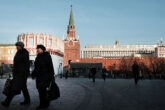October 22, 2021
Reimagining the Eastern Partnership: It is time for the European Union to embrace the Associated Trio
The European Union’s Eastern Partnership (EaP) is facing an identity crisis. In the years since the programme’s inception, the bloc’s relationships with its six former Soviet neighbours have diverged into two distinct groupings. On the one hand, Georgia, Moldova and Ukraine have pushed resolutely forward on their path to European integration. These states now cooperate as part of the Associated Trio format in order to advance their common goal of EU membership. On the other hand, Armenia, Azerbaijan and Belarus have strayed far from EU values and have shown a lack of commitment to deepening relations. Brussels can no longer ignore this dichotomy. As a result, the European Union must fully embrace the Associated Trio if it wishes to achieve its strategic goals in its eastern neighbourhood.
By offering a dedicated approach to the Associated Trio, the European Union stands to gain geopolitical influence in the region.
The 2009 Prague Joint Declaration that established the EaP outlined shared ambitions to “accelerate political association and further economic integration between the European Union and interested partner countries.” The declaration also noted that relations would be “based on commitments to the principles of international law and to fundamental values, including democracy, the rule of law, and the respect for human rights.” Although the European Union took care not to explicitly link EaP membership to eventual EU accession, the geostrategic rationale for the framework was evident. By promoting the internal transformation of the six EaP countries in line with its own values, the European Union stood to benefit from increased stability on its borders as well as heightened regional influence in relation to Russia.
Read the full article from New Eastern Europe.
More from CNAS
-
Ukraine Negotiations: Prospects and Pitfalls of Peace
This week Brussels Sprouts breaks down the latest negotiations on Ukraine. American officials told reporters that they had resolved or closed gaps around 90 percent of their d...
By Andrea Kendall-Taylor & Jim Townsend
-
Can the Global Order Be Saved? Not Without Punishing Russia
The only way to succeed in the urgent task of achieving a just peace settlement, therefore, is radically reshaping Russia’s calculus....
By Nicholas Lokker
-
CNAS Insights | Russia Is Winning the Battle for Influence in Nigeria
Across Africa, Russia and its proxies are well known for providing security and extracting wealth. In the Sahel the Wagner Group, and subsequently the Russian Defense Ministry...
By Kate Johnston
-
Transatlantic Tensions in the New National Security Strategy
On December 4th, the Trump administration released its long-awaited national security strategy, sending another round of shock waves through the transatlantic community. The N...
By Andrea Kendall-Taylor & Jim Townsend




